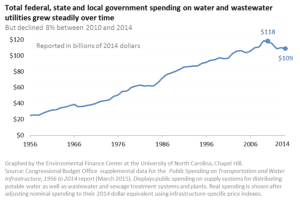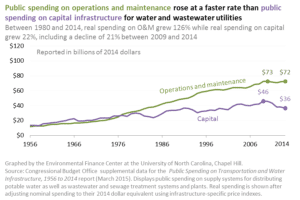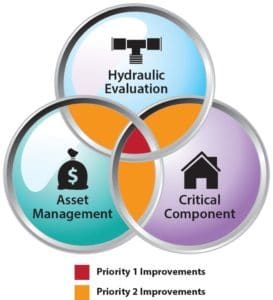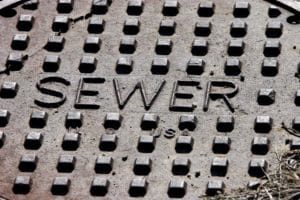Meeting Wastewater Utilities’ Needs Through Capital Efficiency
 Wastewater. It’s something that will always exist, and will always require collection and treatment. Just like improved water, improved sanitation is one of the key contributing factors to a developed nation, significantly improving public health, educational opportunity, and workforce viability. And while the United States boasts nearly 100% improved water and sanitation, there is still cause for concern.
Wastewater. It’s something that will always exist, and will always require collection and treatment. Just like improved water, improved sanitation is one of the key contributing factors to a developed nation, significantly improving public health, educational opportunity, and workforce viability. And while the United States boasts nearly 100% improved water and sanitation, there is still cause for concern.
In the American Society of Civil Engineers (ASCE) 2013 Report Card, wastewater received a “D” grade. Why? Because our existing infrastructure is in desperate need of repair and replacement, and a significant funding gap exists. This gap can be attributed to the fact that funding has been declining while regulations continue to increase.
 In March of 2015, the Congressional Budget Office (CBO) published a report on annual government expenditures on infrastructure, titled Public Spending on Transportation and Water Infrastructure, 1956 to 2014. The data, collected from the Office of Management and Budget (OMB) for federal expenditures and from the Census Bureau for state and local government expenditures, indicates that federal, state, and local governments in the United States have been investing LESS in water and wastewater infrastructure than ever before. From 1956 to the late 1980s, total government spending increased in real dollars by approximately 3%-4% per year, and then from 1%-2% through 2009. These expenditures include both capital and operations and maintenance (O&M) costs. However, from 2010 until present, total government spending has actually decreased by 8%.
In March of 2015, the Congressional Budget Office (CBO) published a report on annual government expenditures on infrastructure, titled Public Spending on Transportation and Water Infrastructure, 1956 to 2014. The data, collected from the Office of Management and Budget (OMB) for federal expenditures and from the Census Bureau for state and local government expenditures, indicates that federal, state, and local governments in the United States have been investing LESS in water and wastewater infrastructure than ever before. From 1956 to the late 1980s, total government spending increased in real dollars by approximately 3%-4% per year, and then from 1%-2% through 2009. These expenditures include both capital and operations and maintenance (O&M) costs. However, from 2010 until present, total government spending has actually decreased by 8%.
 To further complicate matters, capital expenditure has decreased at a faster rate than O&M expenditure. From 1956 to 1980, public spending was basically split between capital expenditures — to build or replace water and wastewater systems — and O&M of the systems. However, since 1980, O&M spending continued to grow at an annual rate of 4%-6% to the 1990s, and then at an annual rate of 1%-3% through 2009, since when it has remained flat. In contrast, capital spending grew at an annual rate of only about 1%-2% since 1980, and has declined at an average annual rate of 4% since 2009. Governments now spend twice as much on O&M of their existing systems than on capital expenditures to repair, rehabilitate, or replace existing assets or for the installation of new infrastructure. In addition, state and local government is now saddled with nearly the full burden of capital expenditure, as federal spending has been steadily on the decline since 1976.
To further complicate matters, capital expenditure has decreased at a faster rate than O&M expenditure. From 1956 to 1980, public spending was basically split between capital expenditures — to build or replace water and wastewater systems — and O&M of the systems. However, since 1980, O&M spending continued to grow at an annual rate of 4%-6% to the 1990s, and then at an annual rate of 1%-3% through 2009, since when it has remained flat. In contrast, capital spending grew at an annual rate of only about 1%-2% since 1980, and has declined at an average annual rate of 4% since 2009. Governments now spend twice as much on O&M of their existing systems than on capital expenditures to repair, rehabilitate, or replace existing assets or for the installation of new infrastructure. In addition, state and local government is now saddled with nearly the full burden of capital expenditure, as federal spending has been steadily on the decline since 1976.
Clearly, municipalities are faced with the almost insurmountable task of staying up to date with all current regulations while also improving outdated and failing systems. Because wastewater collection and treatment is such a crucial aspect of modern day society, it has become paramount that municipalities find cost-effective and efficient ways of maintaining and updating critical infrastructure.

One of the most effective ways in which municipalities can intelligently allocate their limited infrastructure dollars is by implementing a clear and systematic plan of action for capital improvement projects. Typically, asset management is considered to be the standard by which wastewater utilities address capital assets. Defined by the EPA as managing infrastructure capital assets to minimize the total cost of owning and operating them, while delivering the service levels customers desire, asset management certainly plays a key role in smart capital planning. However, asset management should only be part of the equation. Hydraulic modeling and system criticality are two equally important aspects which should be examined when planning long-term capital expenditure.
Tata & Howard’s Wastewater Capital Efficiency Plans™ identify those areas of your wastewater systems needing rehabilitation, repair, or replacement that make the most efficient use of your limited infrastructure dollars by combining the concepts of hydraulic modeling, system criticality, and asset management into a single comprehensive report. Each report is tailored to the individual utility distribution system and provides utilities with a database and Geographic Information System (GIS) representation for each pipe segment within their underground piping system. The CEP report then prioritizes system piping improvements and provides estimated costs for replacement and rehabilitation.
Our three circle approach includes the following:
 Hydraulic modeling
Hydraulic modeling
- Model verification if available
- Compare flows with design carrying capacity
- Hydraulic deficiencies
- History of SSOs
- High infiltration/inflow rates
Critical Components
- Interceptors
- Trunk sewers and force mains
- Residential sewer mains
Asset Management
- Establish score for each pipe segment based on blockages/collapses, I/I rates, installation year, soil corrosivity, PACP structural and maintenance ratings, and other criteria.
A comprehensive CEP provides a utility with not only a prioritized list of logically thought out infrastructure projects, but also a justifiable and defendable plan of action to present to town administrators when planning budgets.
 To continue as a leading industrialized nation, our wastewater utilities must not only remain safe and functional, but also progressive and up to date with current and future regulations. Because funding is declining while costs and population are increasing, it is more important than ever for wastewater utilities to methodically prioritize and plan all repairs and improvements. Only through the implementation of a well-researched and systematic course of action will utilities be prepared to provide safe and dependable wastewater services both now and in the future.
To continue as a leading industrialized nation, our wastewater utilities must not only remain safe and functional, but also progressive and up to date with current and future regulations. Because funding is declining while costs and population are increasing, it is more important than ever for wastewater utilities to methodically prioritize and plan all repairs and improvements. Only through the implementation of a well-researched and systematic course of action will utilities be prepared to provide safe and dependable wastewater services both now and in the future.
